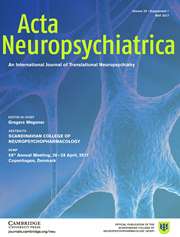Article contents
Attention improvement to transcranial alternating current stimulation at gamma frequency over the right frontoparietal network: a preliminary report
Published online by Cambridge University Press: 02 October 2024
Abstract
Applying transcranial alternating current stimulation (tACS) at 40 Hz to the frontal and parietal regions, either unilaterally (left or right) or bilaterally, can improve cognitive dysfunctions. This study aimed to explore the influence of tACS at gamma frequency over right fronto-parietal (FP) region on attention. The analysis is based on retrospective data from a clinical intervention. We administered test of variables of attention (TOVA; visual mode) to 44 participants with various neuropsychiatric diagnoses before and after 12 sessions of tACS treatment. Alternating currents at 2.0 mA were delivered to the electrode positions F4 and P4, following the 10–20 EEG convention, for 20 mins in each session. We observed significant improvement across 3 indices of the TOVA, including reduction of variability in reaction time (p = 0.0002), increase in d-Prime (separability of targets and non-targets; p = 0.0157), and decrease in commission error rate (p = 0.0116). The mean RT and omission error rate largely remained unchanged. Artificial injection of tACS at 40 Hz over right FP network may improve attention function, especially in the domains of consistency in performance, target/non-target discrimination, and inhibitory control.
Keywords
- Type
- Short Communication
- Information
- Copyright
- © The Author(s), 2024. Published by Cambridge University Press on behalf of Scandinavian College of Neuropsychopharmacology
Footnotes
Tien-Wen Lee and Sergio Almeida contributed equally to this research as co-first authors.
References
- 1
- Cited by



